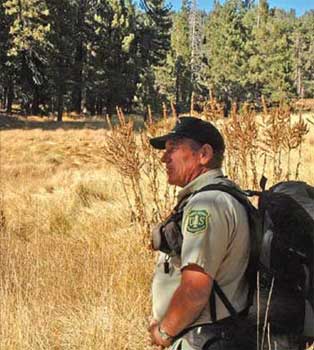Uniforms
The process for determining whether volunteers should wear uniforms, and what the uniforms should consist of, is identical to the process used for employees. Volunteers need to wear a uniform (figure 52a) when they have significant, frequent, or recurring contact with the public or when it is important to establish their authority and/or identification as agency representatives (FSM 1833.4; FSH 6509.11k, sec. 48.03a and 48.03b-4). Most volunteers will wear the volunteer uniform, which consists of a volunteer vest (figure 52b), volunteer windbreaker, and/or volunteer cap (figure 53) (FSH 6509.11k, sec. 48.1(6) and 48.7, exhibit 03). Depending on the service, line officers may determine that a regular uniform is more appropriate for some volunteers (FSH 6509.11k, sec. 48.03b (4)). If your volunteers will be wearing the regular uniform, it will need to be furnished. You can acquire a stockpile of uniforms for volunteers through employee donations (FSH 6509.11k, sec. 48.03f) or a unit purchase (FSH 6509.11k, sec. 48.03g and 48.42e).

Figure 52a—A volunteer ranger assists forest
visitors near Skunk Cabbage
Meadows
in the
San Jacinto Mountains. Courtesy of Brad Eells,
Forest
Service
Volunteer Association, San
Bernardino
National Forest, San Jacinto
Ranger
District

Figure 52b—A volunteer in her volunteer vest
helps a visitor read a forest
map. Courtesy of
Nancy
Coyote, Forest Service, Pacific Northwest Region

Figure 53—A volunteer wearing a volunteer cap
serves with two other volunteers
on a bench. Courtesy
of
Nancy Coyote, Forest Service, Pacific Northwest
Region
You need to make sure that volunteers wear the uniform properly (FSH 6509.11k, sec. 48.03d). The uniform must be neat, clean, and tidy. The field uniform must be complete and cannot be mixed and matched with street clothes (a uniform shirt cannot be worn with blue jeans and a unit baseball cap). However, under special circumstances, the uniform can be worn with safety apparel, such as a high visibility safety vest.
Badges and Patches
Volunteers cannot wear the Forest Service badge, but can wear a volunteer badge in its place. Volunteer badges are available from Western Heritage Co. P.O. Box 445, Encampment, WY 82325.
When volunteers wear the regular uniform, the large Forest Service patch is still worn on the left sleeve and the small patch on the cap (FSH 6509.11k, sec. 48.26f). The volunteer patch may be worn on the right sleeve of the uniform shirt, centered on the sleeve, 2 inches below the shoulder seam (uniform components can be ordered with the volunteer patch in place or the patch can be ordered separately through a unit purchase).
Supervisors may want to consider where the volunteer is assigned when determining whether to use the volunteer patch. Some volunteers feel very strongly that they do not want to wear the volunteer patch, especially in situations where they serve alone and are perceived as an authority figure. They believe it lessens their effectiveness with the public. Some unit managers have chosen not to mandate use of the volunteer patch in these situations.
Name Tags
Volunteer name tags can consist of the standard Forest Service nameplate with the volunteer's name engraved on it or plastic volunteer name tags with the name printed on or attached to the name tags. Name tags are optional with the volunteer uniform. A standard nameplate is required when the regular uniform is worn. For details about what can be on a nameplate, see FSH 6509.11k, sec. 48.7, exhibit 03.
Program Identification Materials
Volunteers may be issued program identification materials, such as patches, pins, decals, t-shirts, caps, and other items that contain the volunteer insignia and are appropriate for local conditions. In high visibility situations—but where an official uniform is not needed—some coordinators provide volunteers with standardized program identification items. For example, a specific district cap and green plastic name tag are sometimes provided for campground hosts. Volunteers who purchase these items can be reimbursed because these items are considered incidental expenses (FSM 1833.4). Volunteers also may be given these items as nonmonetary awards.
Volunteer Identification CardsVolunteer ID cards (FS-1800-17a; appendix C) are available for volunteers who serve 80 hours or more over at least 30 days (FSM 1834.2.) Blank identification cards can be ordered through the Beltsville Service Center, U.S. Department of Agriculture, Office of Operations, Forms and Publications, 6351 Ammendale Road, Beltsville, MD (301–394–0400).
Here is how one unit issues volunteer identification cards.
- The volunteer coordinator is provided with all
of the required information.
- An arbitrary termination date is used if the
actual date is not known.
- The ID card is typed, signed by the issuing
officer (who can be the coordinator), and signed
out to the volunteer on a property card.
- The card needs to be turned in along with other accountable property when the volunteer leaves.
